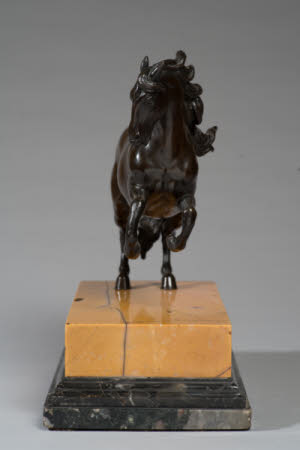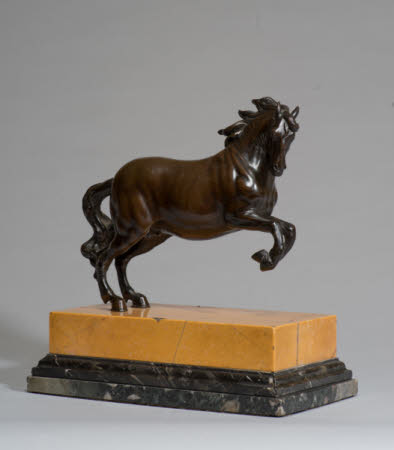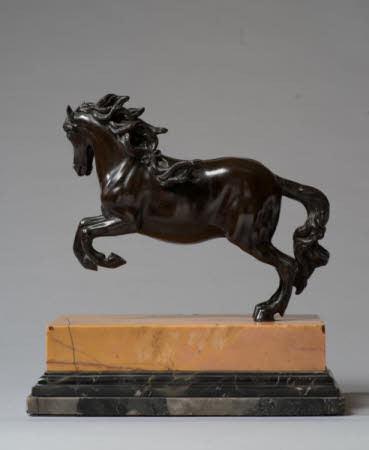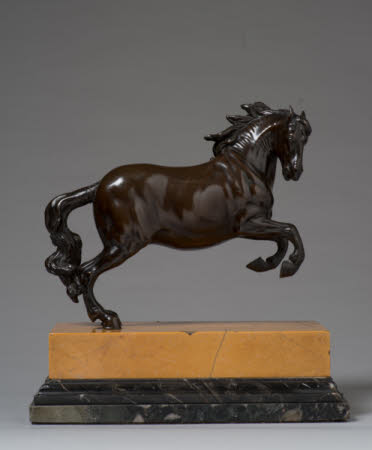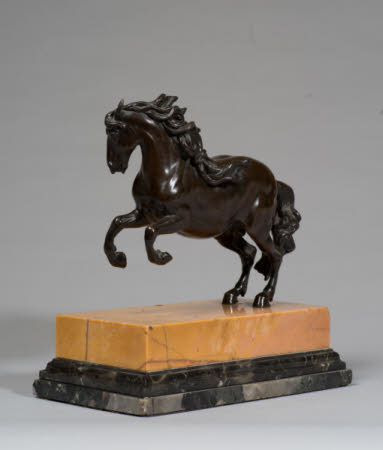A stallion performing the pesade dressage movement
workshop of Ferdinando Tacca (Florence 1619 - Florence 1686)
Category
Art / Sculpture
Date
circa 1640 - circa 1660
Materials
Bronze
Measurements
183 x 213 mm
Place of origin
Florence
Order this imageCollection
Anglesey Abbey, Cambridgeshire
NT 514991
Summary
Bronze, A stallion performing the pesade dressage movement, workshop of Ferdinando Tacca (1619-1686), c. 1640-1660. A bronze sculpture of a rearing stallion from the workshop of Ferdinando Tacca (Florence, 1619-1686), showing the animal rearing on its hind legs, its head turned to its right. Its mane, which is tied with a ribbon, flies out to the side. Mounted on a yellow Siena marble base. In a pair with NT 514992.
Full description
This pair of rearing stallions appear on the one hand to be wild animals, as they leap forward, their manes and tails flying wildly and with no traces of any harness. However, they are shod and the mane of one of the stallions is tied with a bow. It has been suggested that the models in some way illustrate the art of dressage, in which highly trained horses undertake choreographed moves. NT 514991 seems to execute the movement known as the pesade (la posata), in which the horse rears up on its hind legs, with its forelegs drawn in; NT 514992 the curvette (la corvette), in which the horse springs forwards with its hind legs outstretched, whilst its forelegs descend. The models are known in a number of versions in museums and private collections across the world. The best pair is that in the Museo del Palazzo di Venezia in Rome (Invs. 9292-9293. Pietro Cannata, Museo Nazionale del Palazzo di Venezia. Sculture in Bronzo, Rome 2011, nos. 91 and 92). When compared to the Anglesey Abbey pair, the horses’ manes are more finely worked, the teeth are properly delineated, veins are visible along the animals’ flanks and the patination is better preserved. An example of the horse performing the curvette, shown by the dealers Steinitz at the Masterpiece Fair in London in 2018, was of equivalent quality. Other examples include a pair formerly in the Robert von Mendelssohn collection (Gordon Balderston, European Sculpture, Daniel Katz Ltd., London 2004, no. 19), another pair at Polesden Lacey (NT 1246220) and a single example of the horse performing the curvette in the Robert H. Smith collection (Anthony Radcliffe and Nicholas Penny, The Robert H. Smith Collection. Art of the Renaissance Bronze 1500-1650, London 2004, no. 48). The models were associated as long ago as 1912 with the Italo-Flemish sculptor Giovanni Bologna (Giambologna, 1529-1608) or his assistant and successor Pietro Tacca (1577-1640). At the Giambologna exhibition held in Edinburgh, London and Vienna in 1978-79, Katharine Watson correctly identified them as the work of Pietro’s son Ferdinando Tacca (Charles Avery and Anthony Radcliffe, eds., Giambologna 1529-1608. Sculptor to the Medici, London 1978, nos. 164 & 165). Ferdinando Tacca (1619-86) succeeded his father as court sculptor and architect to the Medici Grand Dukes in Florence, inheriting the workshop established by Giambologna and successively occupied by Pietro Tacca. Whilst Ferdinando Tacca continued to use some of the models developed by Giambologna and by Pietro Tacca, he had his own more Baroque vocabulary, as can be seen in these spirited horses. Ferdinando was also active as an engineer and as a pioneering theatre architect, also as designer of the sets for many theatrical productions in Florence. Jeremy Warren 2019
Provenance
Acquired by Urban Huttleston Rogers Broughton, 1st Lord Fairhaven (1896-1966), by 1940; identifiable in the Anglesey Abbey inventory of 1940, p. 12, The Oak Room, ‘A pair of Bronze prancing horses on Giallo Antico and grey marble plints [sic]’, valued at £60; bequeathed to the National Trust in 1966 by Lord Fairhaven (1896-1966) with the house and the rest of the contents.
Credit line
Anglesey Abbey, The Fairhaven Collection (The National Trust)
Makers and roles
workshop of Ferdinando Tacca (Florence 1619 - Florence 1686), sculptor
References
'Anglesey Abbey, Lode, Cambridgeshire. An Inventory and Valuation of Furniture, Books, Ornamental Items & Household Effects .. prepared for Insurance Purposes’, Turner, Lord and Ransom, April 1940, p. 12. Christie, Manson & Woods 1971: The National Trust, Anglesey Abbey, Cambridge. Inventory: Furniture, Textiles, Porcelain, Bronzes, Sculpture and Garden Ornaments’, 1971, p. 139.
